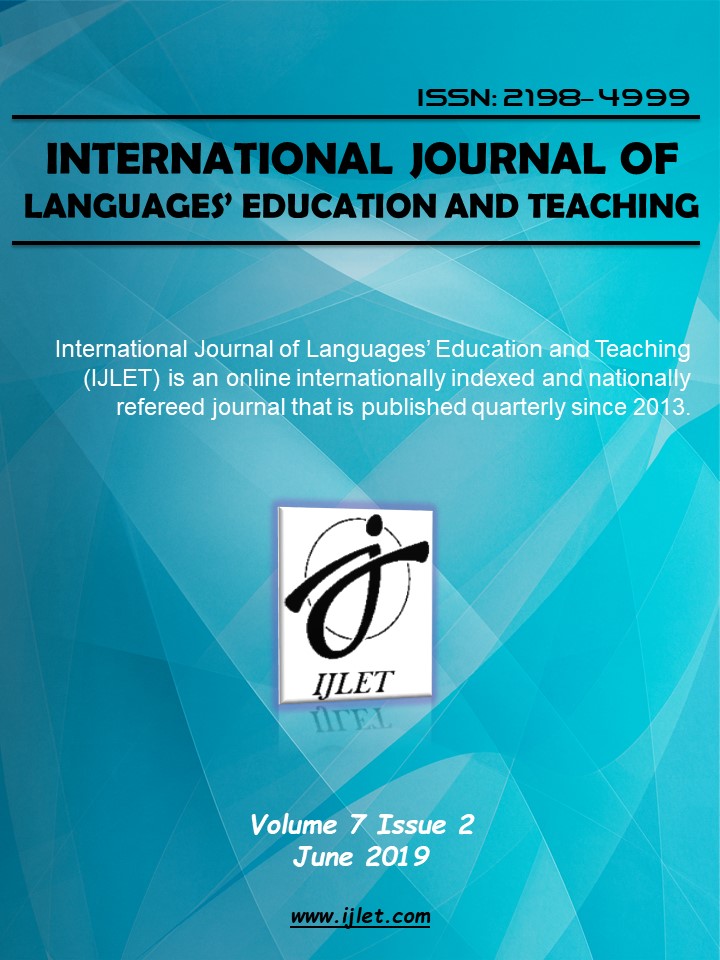Shakespeare’in Antony and Cleopatra Oyunundaki Anlatı Tekniklerinin Çeviri Göstergebilimi Bakış Açısıyla Çözümlenmesi ve Çevirilerinin Değerlendirilmesi
Author :
Abstract
Bu çalışmanın amacı, Shakesperare’in Antony and Cleopatra oyunundaki anlatı tekniklerini bulmak ve anlatı teknikleri saptanan söylemlerin Türkçe çevirilerinin değerlendirmesini yapmaktır. Bu amaca yönelik olarak, oyunun kaynak metni çeviri göstergebilimi bakış açısıyla anlatı tekniklerini saptamak için çözümlenmiştir. Çeviri değerlendirmesi için, oyunun farklı çevirmenler tarafından yapılmış, her birinin arasında en az on yıl olacak şekilde seçilmiş üç Türkçe çevirisi çalışmaya dahil edilmiştir. Kaynak metnin çözümlemesi sonucunda 30 söylemde anlatı teknikleri saptanmış, ancak çalışmanın amacı dikkate alındığında – kaynak metinde anlatı teknikleri saptanan söylemlerin Türkçe çevirilerini değerlendirmek- sadece erek metinlerin en az birinde anlam dönüşümü saptanan sekiz söylem bu çalışmaya dahil edilmiştir. Diğer 22 söylemin Türkçe çevirilerinde herhangi bir anlam bozucu eğilim saptanmaması sebebiyle o söylemler bu çalışmanın dışında tutulmuştur. Anlatı teknikleri bulunan bu sekiz söylemin dördünde önceleme anlatı tekniği, diğer dördünde ise sona olta atma anlatı tekniği saptanmıştır. Çeviri değerlendirmesi sonuçlarına göre, bu sekiz söylemin üç farklı Türkçe çevirisinde toplam 10 anlam bozucu eğilim saptanmıştır. Bu anlam bozucu eğilimlerin beşi anlamın kaydırılması, biri anlamın aşırı yorumlanması, biri anlamın bozulması, biri anlamın çarpıtılması, biri anlamın parçalanması, biri anlamın yok edilmesi eğilimleri olarak karşımıza çıkmıştır. Bu bulgulardan anlaşılabileceği üzere, yazın çevirmenleri kaynak metnin anlamlamasında çeviri göstergebilimi modelinde öne sürülen çözümleme adımlarını kullanabilir ve çeviride ne tür anlam dönüşümleri oluştuğu hakkında bilgi sahibi olurlar.
Keywords
Abstract
The purpose of this study is to determine the discursive techniques in the play Antony and Cleopatra by Shakespeare and conduct an evaluation of Turkish translations of those contexts with discursive techniques. To this end, the source text of the play was analyzed for discursive techniques based on semiotics of translation model. For translation evaluation, three Turkish translations of the play by different translators each published with a time gap of at least one decade were chosen. The analysis of the source text yielded 30 contexts with discursive techniques. However, translation evaluation of those 30 contexts showed that there were designificative tendencies in target texts in only eight of those contexts, with the rest 22 contexts translated into Turkish preserving the discursive techniques with no designificative tendency. Therefore, in line with the general purpose of this study, -that is to evaluate Turkish translations of the contexts with discursive techniques in the source text from the point of view of semiotics of translation, only those eight contexts were included in this study. Of those eight contexts with discursive techniques, four were produced through anticipation technique while the other four were produced with priming technique. The results of the translation evaluation showed that in translation of those eight contexts into Turkish, a total of ten designificative tendencies were found in three target texts. Of those ten tendencies, five were sliding of the meaning, one was over-interpretation of the meaning, one was alteration of the meaning, one was opposition of the meaning, one was destruction of meaning, and finally one was wiping out of the meaning. It can be concluded from those findings that literary translators could benefit from the steps of semiotics of translation in the signification of the source text and have an awareness of designificative tendencies in translation.
Keywords
- Genette, G. (1972). Figures III. Paris: Editions du Seuil.
- Genette, G. (1972). Figures III. Paris: Editions du Seuil.
- Gorlée, D. L. (1994). Semiotics and the problem of translation: With special reference to the semiotics of Charles S. Peirce. Amsterdam: Rodopi.
- Karantay, S. (1995). Tiyatro çevirisi: Oyun dili ve çeviri. Mehmet Rifat (Ed.). Çeviri ve çeviri kuramı üstüne söylemler içinde (s. 93-115). İstanbul: Düzlem Yayınları.
- Kourdis, E. ve Kukkonen, P. (2015). Introduction-Semiotics of translation, translation in semiotics. Punctum International Journal of Semiotics, 1(2), 5-10.
- Ludskanov, A. (1975). A semiotic approach to the theory of translation. Language Sciences. 35, 5-8. Nutku, Ö. (2013). Shakespeare sözlüğü. İstanbul: İş Bankası Kültür Yayınları.
- Öztürk Kasar, S. (2001). La sémiotique subjectale et la traduction. Third International Congress – Claims,Changes and Challenges in Translation Studies Abstracts, 30 Ağustos-1 Eylül 2001. Kopenhag: European Society for Translation, Copenhagen Business School: 24-25.
- Öztürk Kasar, S. (2006). Contribution sémiotique a la quete du sens en traduction littéraire. M. Lederer (Ed.). Le sens en traduction içinde (s. 225-233). Caen: Lettres Modernes Minard.
- Öztürk Kasar, S. (2009). Pour une sémiotique de la traduction. C. Laplace, M. Lederer, D. Gile (Ed.), La traduction et ses métiers içinde (s. 163-175). Caen: Lettres Modernes Minard.
- Öztürk Kasar, S. (2012). Jean-Claude Coquet ile bir dil görüngübilimine doğru. XII. Uluslararası Dil, Yazın ve Deyişbilim Sempozyumu Bildiriler Kitabı içinde (s. 427-433). Edirne: Trakya Üniversitesi.
- Öztürk Kasar, S. (2017). Jean-Claude Coquet ve söyleyenler göstergebilimi. İ.O. Ayırır, E. Korkut (Ed.). Prof. Dr. Ayşe Eziler Kıran’a armağan içinde (s. 183-199). Ankara: Hacettepe Üniversitesi Yayınları.
- Öztürk Kasar, S. ve Tuna, D. (2015). Yaşam, yazın ve yazın çevirisi için gösterge okuma. Frankofoni Fransız Dili ve Edebiyatı İnceleme ve Araştırmaları Ortak Kitabı, 27, 457-482.
- Petrilli, S. (2007). Interpretive trajectories in translation semiotics. Semiotica. 163, 311-345. Ricoeur, P. (2008). Çeviri üzerine. (S. Öztürk Kasar, Çev.). İstanbul: YKY.
- Shakespeare, W. (1949). Antonius ve Kleopatra. (H.-E. Adıvar ve M. Urgan, Çev.). İstanbul: Pulhan. Shakespeare, W. (1950). Antony and Cleopatra. Cambridge: University Press.
- Shakespeare, W. (1967). Antonius ve Kleopatra. (S. Eyüboğlu, Çev.). İstanbul: Remzi Kitabevi.Shakespeare, W. (2002). Antonius ve Kleopatra. (B. Bozkurt, Çev.). İstanbul: Remzi Kitabevi.
- Stecconi, U. (2007). Five reasons why semiotics is good for translation studies. Yves Gambier, MiriamShlesinger, Radegundis Stolze (Ed.), Doubts and directions in translation studies içinde (s. 314-319) Amsterdam: John Benjamisn Publishing Company.
- Torop, P. (2000). Towards the semiotics of translation. Semiotica. 128(3-4), 597-610.
- Tuna, D. ve Kuleli, M. (2017). Çeviri göstergebilimi çerçevesinde yazınsal çeviri için bir metin çözümleme ve karşılaştırma modeli. Konya: Eğitim Yayınevi.
